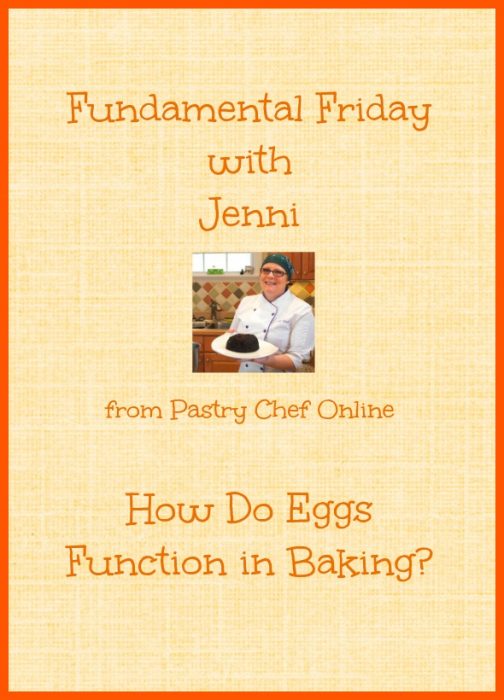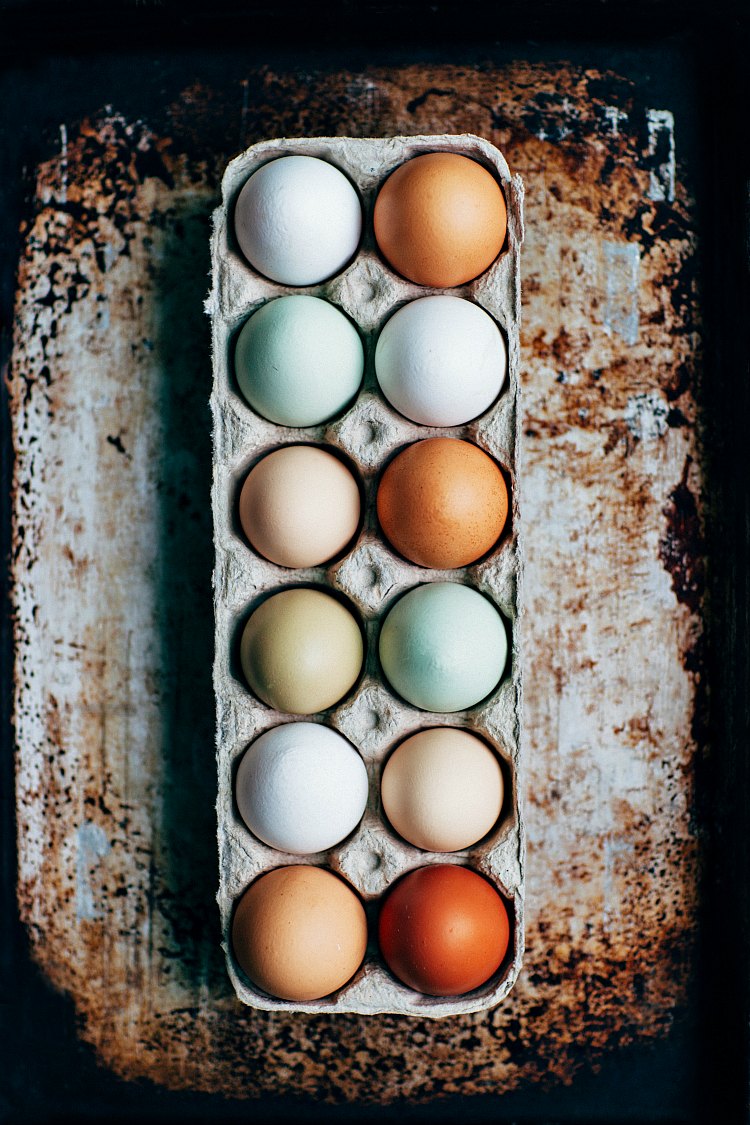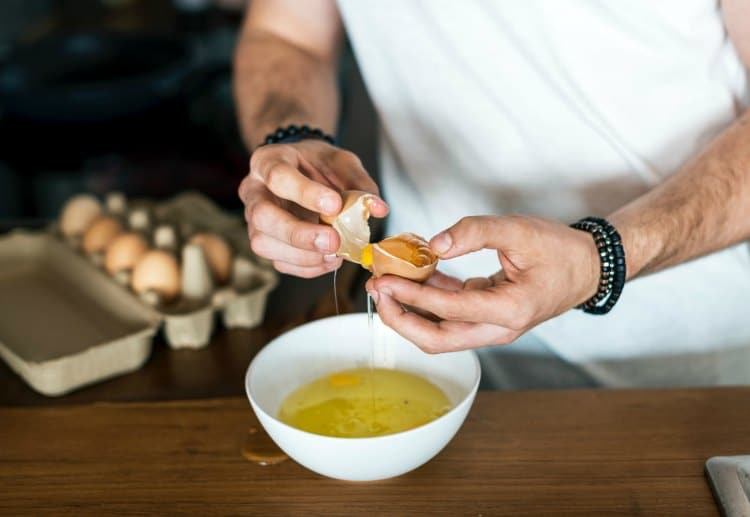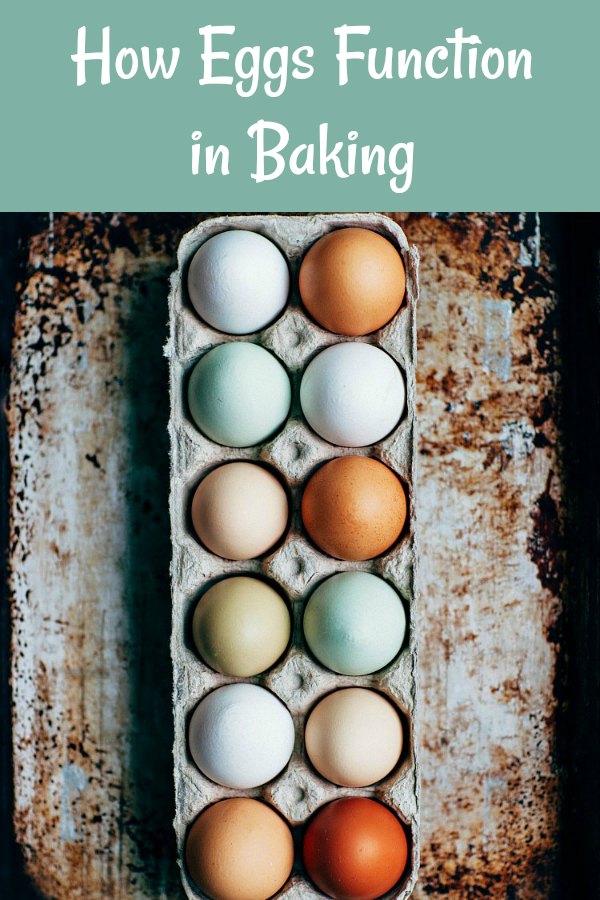This post will teach you how eggs function in baking, or put another way, it will hopefully help answer the question about what eggs do in baking. You may also enjoy my post about how to temper eggs.
Eggs are really versatile, and because they have 2 parts that behave differently, we’ll look at how egg yolks work, what egg whites do, and how whole eggs act in baking.
This post will focus mainly on cakes with some information at the end about custards.
Part of a series called Ingredient Function,

This post contains affiliate links. For more information, please see my disclosure policy.
What Eggs Do In Baking
The egg is quite possibly the most versatile basic baking ingredient on the planet. I think it has to do with its having two parts: a fatty yolk and a proteiny, watery white.
You can also use:
Pastry Chef Online Participates in Affiliate Programs. If you make a purchase through one of my links, I may earn a small commission. For more information click to read my disclosure policy
- just yolks
- just whites
- a combination of the two.
Where to begin? Like Maria, I say let’s start at the very beginning…

Photo by Kelly Neil on Unsplash
Egg Basics
An egg is “the hard-shelled reproductive body produced by a bird and especially by the common domestic chicken; also : its contents used as food.” So sayeth Mirriam-Webster online.
Thanks, Mirriam Webster for not bothering to discuss the contents of an egg, because for most of us interested in baking with eggs, we are only interested in what is inside the shell.
Parts of the Egg
Eggs contain several structures including membranes and air pockets and such, but the main parts of the egg we are concerned with as bakers and cooks are:
- the yolk
- the albumin or white
- the whole egg, or the yolk and white together
A Note on Egg Whites
I will say here that the albumin can be further divided into thick albumin and thin albumin.
I’m sure you’ve all seen this: there’s a thicker, almost jelly-like white around the yolk and a thinner, more watery substance that runs out into your pan or bowl.
The fresher the egg–the more recently laid–the more of the thicker part there is and the less of the thinner.
That’s why older whites are preferable to younger whites for whipping. It’s much easier to whip air into a thinner mixture than it is with a thicker one.
What Do Eggs Do In Baking?
To really understand all the myriad ways eggs function in baking, we have to look at the ways eggs are called for: whole eggs, just yolks or just whites. Because nothing is ever easy. Still, this will be Fun and Educational!
Whole Eggs

The fat/protein/water content of whole eggs is:
- 12% fat
- 13% protein
- 73% water
- 2% minerals and such.
A whole large egg has about 80 calories.
- They add structure in the form of protein. As eggs bake in a cake, the proteins denature and coagulate which, along with the starches in flour help form the overall structure of your baked goods. Too much egg not balanced with sugar and fat (which both tenderize) and yield tough, dry or chewy results.
- Yolks contain emulsifiers that help to form a thick, luscious batter that doesn’t separate. An emulsifier helps two items who don’t normally get along (fat and water in this case) get along. That’s why adding just a bit of egg yolk to a salad dressing helps to keep the oil and vinegar in solution. In this case, eggs add volume to batter and an even texture to the final product.
- They contribute to browning because of Maillard reactions. Maillard reactions are the set of browning reactions that occur when proteins are heated. As well, they lend a yellowish cast to batters and dough.
- The yolks add some trace minerals and up the nutritional value while whites up the protein content.
- They contribute to the overall flavor of whatever you’re making, partly because the fat in the yolks helps to carry other flavors.
- Since eggs are mostly water, they contribute to the overall moisture content of whatever you’re making. If you are making an enriched bread for example and you decide you want to only use yolks rather than whole eggs, you will have to increase the amount of water or other water-type liquid in the formula so that the bread won’t be too dry. So yes, I realize that I have said eggs both dry and contribute moisture. Both are true. There are many sides to eggs.
- The fat in yolks helps to shorten gluten and tenderize the final product.
Recipes Containing Whole Eggs
Egg Yolks
Although the yolk makes up roughly 1/3 of the volume of a whole egg, it contains half the protein, all of the fat and almost all the vitamins and minerals. It also contains three times as many of the calories as the white (60 as opposed to 20). Yolks are made up of 49% water, 17% protein and 32% fat along with 2% minerals and such.
- While yolks are made up of roughly half water, the actual amount is about 8 grams, or 1 1/2 teaspoons. This is a minimal amount compared to using whole eggs, and with all the emulsifiers and fats in a yolk, they contribute more of a shortening and tenderizing function than whole eggs.
- Baked goods made with yolks only are richer and more tender than those made with whole eggs. Less water equals less gluten development, and the fats in the yolk weaken the gluten that is present.
- Yolks contribute a lot of color, much more so than using whole eggs. Baked goods made with yolks only have a lovely deep golden hue. Their protein content assures lovely browning thanks to Maillard reactions.
- Batters made with just yolks are rich and billowy and luscious, partly due to all the emulsifiers present in the yolks.
- If the only difference between two batters is one is made with whole eggs and one is made with yolks, the yolky batter will contain more vitamins, fatty acids and trace minerals than the whole egg version.
- Yolks add a mellow, “eggy” flavor to baked goods. Either you are a fan of that eggy flavor, or you’re not, so consider that when deciding whether to bake with yolks only. Yolks can also muddy the flavor of other ingredients, mellowing and muting them. Again, some folks like this and some folks don’t.
Egg Yolks as Emulsifiers
Another important function of eggs, specifically egg yolks, is that they contain several emulsifiers. One emulsifier in egg yolks you may have heard of is lecithin.
Emulsifiers are molecules that have one end that likes to hang out with fats and another end that hangs out with water. Add an emulsifier to a water-type/oil-type mixture, which normally would separate upon standing, and they’ll hang together. This means we can harness the power of emulsifiers in egg yolks for the following purposes and more:
- Egg yolks join the fat in butter with the water in milk and egg whites to create a smooth cake batter.
- Adding a touch of egg yolk to a vinegar and oil mixture (heavy on the oil), and you end up with a lovely emulsified mayonnaise.
- Egg yolks join the water in lemon juice with the fat in butter to make a creamy Hollandaise sauce.
Recipes Containing Egg Yolks
Egg Whites

The albumin or white of an egg contains 86% water, 12% protein, no fat at all and 2% minerals and such. When you realize whites make up two thirds the volume of the egg but only contain 1/3 the calories, it’s easy to understand why folks who are on a diet favor using whites only.
- Baked goods made with whites only are pale in color, especially if they don’t contain any other “coloring agents,” either natural (such as spices) or artificial (like food coloring). If you’re going to make those rainbow cakes, start with a whites-only batter so your colors stay true.
- While whites are mostly water, they have a drying effect on baked goods since all that water activates gluten without the tenderizing influence of the fat in the yolks. Most whites-only cakes (think angel food cake) rely heavily on the addition of extra sugar to tenderize the structure and bring moisture to the final product.
- Whites don’t contribute to the overall flavor of whatever you’re making. This means that the flavors you do introduce are more pure tasting since yolks bring a mellowness.
- There are no emulsifiers in egg whites, so batters containing whites only as well as other liquids are more prone to breaking or having a slightly curdled look to them. Angel food cake is an exception because the only additional liquid in an angel food cake is maybe a bit of extract.
- While the color of the dough or batter is whiter, you should still be able to achieve a nice brown crust on whatever you’re making because of the protein in the whites and sugar. Again with the Maillard reactions.
Recipes Containing Egg Whites
Okay, I think that pretty much covers what eggs do in baking cakes and such.
You can find my discussion of the function of eggs in custards here.
What Can I Use In Place of Eggs? Are There Good Egg Substitutes?
I bake with eggs. I love all the roles they play in baking and cooking, and I love the flavor.
But for folks who cannot have them due to allergies or for people who do not eat eggs (broadly: vegans), there are some viable substitutes.
- To approximate the flavor of eggs in dishes where eggs are usually the star (deviled eggs, and tofu scramble, for instance), you can sub in some black salt called kala namak. This salt is high in sulphur compounds and so can act as an egg flavor replacer. I would not suggest you use it in sweet dishes, though. NOTE: the salt is not black but more of a pink-beige color. I have no idea why they call it black salt.
- To approximate the texture of eggs in cakes, you can use ground flaxseed mixed with water in a ratio of 1 Tablespoon ground flax to 2-3 Tablespoons water per egg needing to be replaced. Let it sit for a few minutes until it gets a little “gloopy,” like egg whites. TIP: in baking cakes where I want a nice, fine texture, I make sure the flaxseed is extra fine by whirring it up super fine in my blender.
- You can also use aquafaba (the thickened water from canned chickpeas) as an egg replacer in both sweet and savory cooking and baking. The Kitchn has a great post on using aquafaba as an egg replacer.
- Bigger Bolder Baking also has an excellent post about 7 common egg replacers to use in baking.
Some Interesting Egg Facts to Ponder
- Eggs are one of the leading food allergens. When folks have an egg allergy, generally it is to one (or a combination of) the proteins present in the whites. I’m not saying that people with egg allergies are cleared to eat yolks, of course. I just find it interesting.
- Eggs do not like really high temperatures. This is why we often bake custards in a water bath. The part of the batter that is submerged in the water (in a pan, of course) can never rise above the boiling point of water, or 212F/100C.
- Eggs like gentle cooking, and the more slowly you can cook them, the more silky, creamy and sexy your custard will be.Have you ever had a baked custard that has a weird, grainy texture? This happens when the eggs cook too quickly, the proteins seize up tight and squeeze out all the liquid.And what are you left with? A nubbly, tweedy texture. Ew. I cannot tell you how many pieces of flan I’ve sent back. Sigh.
- Grocery store eggs, at least here in America, have been washed so they’re all clean and pretty. This removes the protective coating that they naturally have, allowing them to pick up off-flavors in the fridge and to age more quickly.We get our eggs from our own chickens, and I can tell you that we are happy when they come out clean, but we don’t expect it. Either way, clean or not, we just wipe them off and keep them on the counter until we need to use them.We wash them right before use, thus protecting the coating on them which allows them to sit out at room temperature in the first place. (And this is all within reason, of course. It’s not like we’re using eggs that have sat out on the counter for months and months.)
I am sure I have left out some information about what eggs do in baking, so after reading all of this, please let me know if you still have any questions.
You can leave them here in the comments or shoot me an email. Either way, I’m happy to help, especially if helping one can help all figure out how eggs function in baking.
It will help me and other readers so much if you take a moment to rate and leave a review for this recipe.
You can use the stars to rate 1-5 (5 is best), and leave a review in the comments. It helps me make adjustments if any are needed, and comments help others decide whether the recipe is worth making.
Other ways to share include pinning, and/or sharing on your favorite social media platform.
Thank you so much for taking the time!

Because knowledge is power, friends. Learn how ingredients function–how eggs act in baking and cooking, in this case–so you can make them do what you want them to.

Hi, y’all! I hope you’ve enjoyed this post and hopefully also learned a thing or two.
If you like my style, I invite you to sign up for my occasional newsletter, The Inbox Pastry Chef.
Expect updates on new and tasty recipes as well as a bit of behind-the-scenes action. I hope to see you there!
Thanks for spending some time with me today. I appreciate it.
Have a lovely day.
I did know most of the information presented here, but I want to credit some outside research from my main textbook in culinary school.
Professional Baking, 4th Edition, Wayne Gisslen, pp47-50



Join in Today!

Hello Jennifer and thank you kindly for all the work you seem to tirelessly do and for your generosity in sharing your knowledge – and tips – with us strangers.
I have a question, which is closely linked to a pet peeve of mine, the extent of which I will try not to share in a rant (much). Maybe you’ll surmise its nature just from my question/quandary. Best to get to it then.
Changes in egg size is an example. Smaller large egg and more expensive.
I unfortunately don’t have laying hens – or any hens for that matter. Boo for me. Maybe another lifetime. I also mostly do not cook (anymore), and particularly do not bake desserts (pastries or otherwise).
When it comes to cakes, I have always been a one-trick pony, i.e., what’s generally called an old-fashioned Southern POUND cake. One of my very dear friends drools at the idea of one of “my” pound cakes. For a number of reasons, she hasn’t had that particular pleasure for way too many years.
It’s finally time to provide this gift to her. I’m outright frightened. What if it doesn’t deserve her drool?
Enough. It seems I’m too frightened to even get to my Q. Please excuse.
Okay, here it is. How many of these dad-blasted ridiculously tee-niney tiny eggs, now sold for LARGE eggs, do I use – in place of the six large eggs called for in the recipe?
Seriously. When I opened the box marked as large eggs, I was stunned. I didn’t know a chicken could even lay an egg that small. I bet it’s easier for the hen but it’s h*ll on use in the real world (or so I declare).
It’s one thing to use it in deviled eggs. I can just devil more. Even salads are quite accepting. Certainly there are many cases where it doesn’t matter or adapting is just matter of innovation. But, in cakes! Where the right balance is said to be so critical! Ahhh … exasperating at the least.
My plan is to make a trial cake (tonight/this morning). Maybe this will give me a clue, before my friend’s visit, if I can still make her dream (drool) cake. I will use 8 of these tiny eggs that wobble around loose in their individual segment of the egg crate (made for what at some time in the past was a true large egg). That is 2 more than listed in the original recipe.
It’s been years I think since the FDA allowed egg suppliers to downgrade the size of eggs, classifying a medium egg as large, a small egg for medium, etc. In my world they’ve downgraded again, w/o adherence to the official specifications. Maybe the pandemic is to blame.
I only know I want a delicious and beautiful cake for my friend, like the good old days.
Any tips? Assuming you were able to get through this lengthy epistle. I wonder if I’ll have to break it up to fit in the comment box. Yikes!
Hopeful in Asheville.
Hi, Vicky! I see you; I hear you; I feel your pain! lol
Seriously, though, you are correct, eggs are SHRINKING!
“Back in the day,” large eggs out of the shell weighed in at roughly 50 grams per egg. So for a six-egg cake, you’d need 300 grams of whole egg.
If you have a kitchen scale, your best bet is going to crack the wee eggs into a bowl on the scale until it weighs 300 grams. In ounces, that’s 10.5-ish ounces.
If you don’t have a scale, you can use a large wet measuring pitcher, because whole eggs weight and volume measure is the same (the old the pint is a pound the world around thing).
So if all you have is a measuring cup, you’ll need just over 1 1/4 cups of whole egg.
And now is the time I tell you to buy a scale if you don’t have one and convert all your measurements to weights. Measure out your cup of flour for the cake and then weigh it. Write it down. Now you know how much *your cup* weighs.
Hope this helps, and I hope we don’t end up needing to use 426 hummingbird-sized eggs in the future. The way things are going, I wouldn’t be surprised, though.
I know your friend will enjoy the cake. You’re a Good Egg!
Hi jennifer,
i saw your comment above doing the math for milk + oil substitute. Appreciate that as i always bake with science involved:/
that said, im wondering if the flax you used for body of the baked goods can be replaced with corn starch? if so, how much would it be and if not, why not?
i’m trying to substitute eggs in blondies and cookies, and they often turn out cakey instead of the gooey texture i would love. im not sure why, please advise!
I wouldn’t recommend replacing flax eggs with cornstarch. You’d definitely get more structure, but you may also end up with a really dry product. The ground flax gels and helps to hold onto moisture. Generally speaking, cornstarch is usually used to replace some of the wheat flour in a recipe to give bulk but without adding extra gluten. I have experimented with using Instant Clear Jel (which is just modified food starch: corn starch that gelatinizes without being heated) and the results of using a lot was like chewing cotton wool. And even in smaller amounts, the result is cakey, which is not what you want.
Are you saying that flax eggs yield a cakey texture in your blondies? If so, you might consider trying aquafaba instead. 2-3 T aquafaba (liquid from canned chickpeas) in place of the egg or flax egg.
Although, if you *haven’t* tried using flax eggs, I’d recommend it. Definitely blitz up even “preground” flax in a blender to make it as fine as possible so it doesn’t adversely affect the texture of your batter/cookie dough. Try 1 Tablespoon ground flax with 2-3 T water. Stir and let it gel for about 5 minutes before using.
Does the age of an egg matter at all in baking? Can you use “old” eggs without affecting the final product in a cake or quickbread?
What a great question! To a certain extent, the age doesn’t really matter as long as the egg is still good. Fresher eggs are easier to separate than older eggs, and the albumin thins out somewhat in older eggs. So, using whole eggs or just yolks should be fine. I’d be a little more cautious about using just old whites, like for meringue or for angel food cake. I think a meringue made with fresher eggs should stand up better than one made with old whites. Hope that helps!
I object the sarcastic attitude toward Merriam Webster! A discussion of the contents of an egg belongs in an encyclopedia, not a dictionary. Merriam Webster provided a perfectly satisfactory definition for the scope of a dictionary.
I would be happy if that comment were edited to not put Merriam Webster in a negative light.
Thanks!
I was joking. Of course you’re not going to get an exhaustive discussion of the function of an egg from a dictionary. It just gave me a place to start. I’m a fan of dictionaries. 🙂
Hi–Thank you for your post. I have used flax seeds and water to replace eggs before. However, what if the recipe calls for yolk only? Would I just make the flax egg replacement and then only use a yolk-sized portion of it? Thanks!
Hey Stephanie. That’s a very good question. I suppose it would depend on what part the yolks play in the recipe. If it’s for fat and richness, I think adding an additional 2 teaspoons of fat would work just fine. And at such a small volume (if we’re only talking about 1 yolk) you may just be able to omit it. What recipe are you trying to leave the yolks out of?